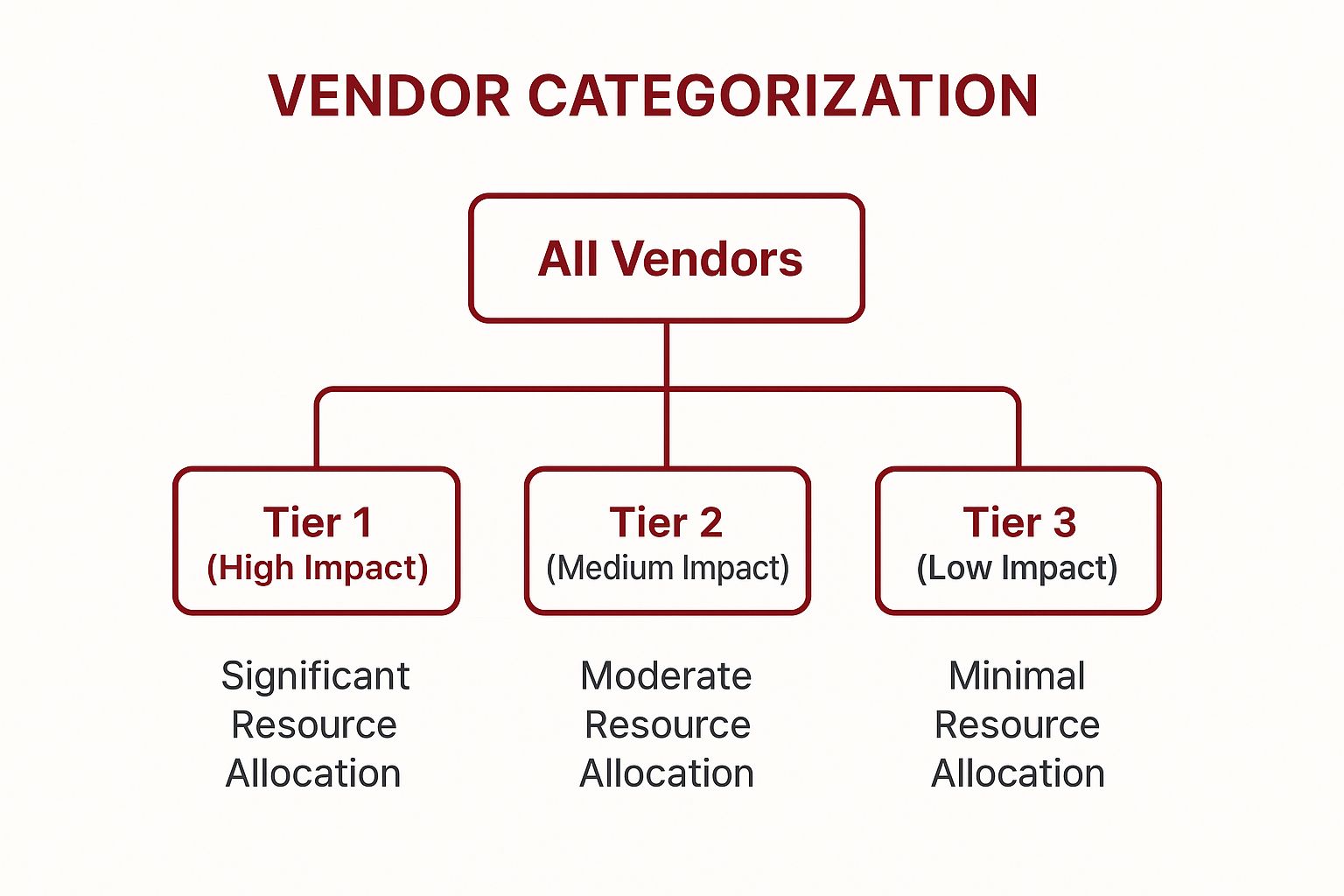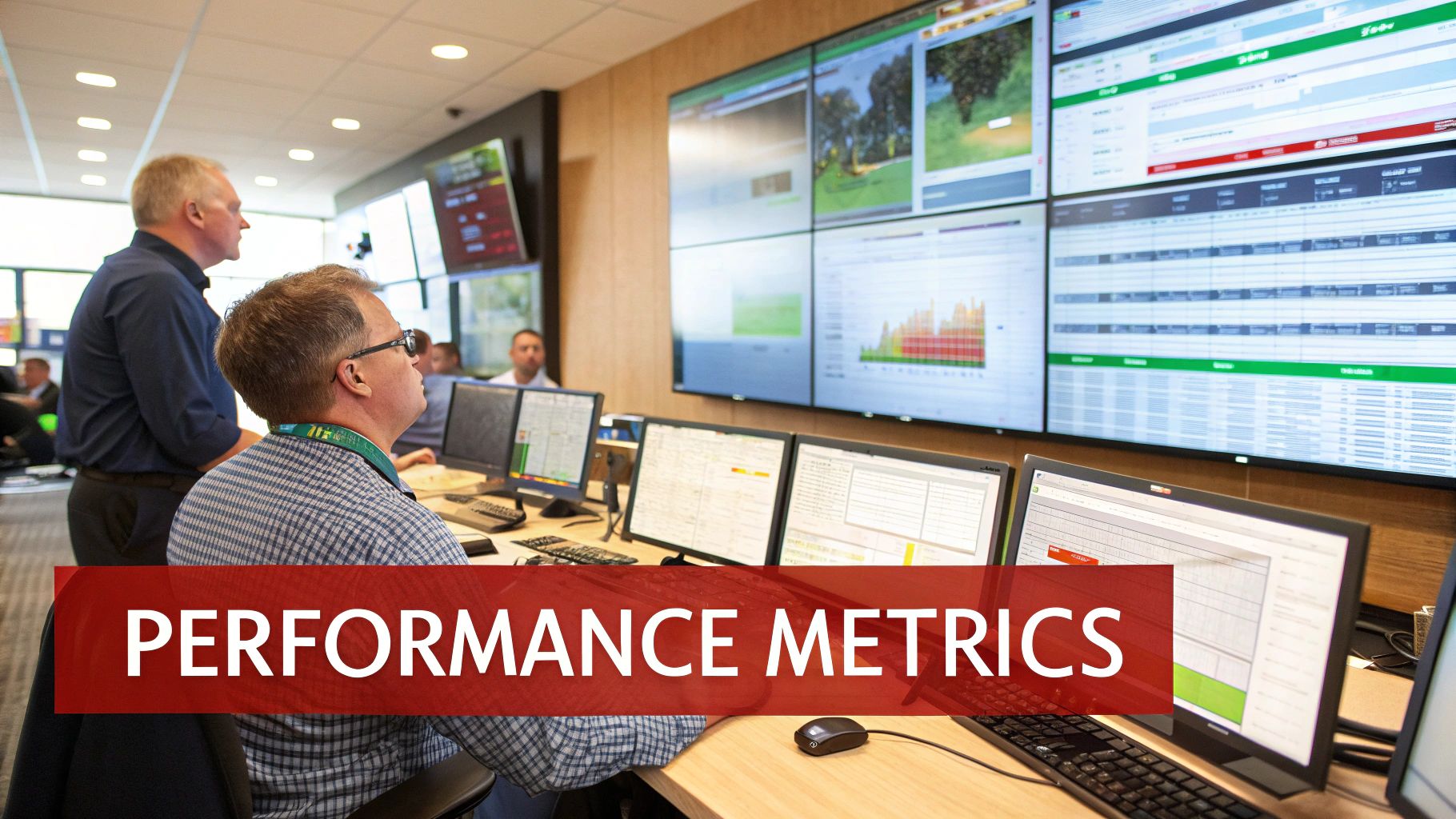Unlocking Strategic Advantage: Why Vendor Management Matters More Than Ever
In today's interconnected business ecosystem, the vendors you partner with are no longer just suppliers; they are integral extensions of your organization. From technology providers and logistics partners to corporate gifting specialists, your vendor network directly impacts your operational efficiency, brand reputation, and bottom line. Merely managing transactions is a relic of the past. Modern success hinges on building strategic, resilient, and value-driven vendor relationships. This requires a sophisticated approach that goes beyond simple cost-cutting to encompass risk mitigation, performance optimization, and collaborative innovation.
Whether you're a rapidly growing startup or an established enterprise, mastering a set of proven vendor management best practices is crucial for navigating complexities and turning your supply chain into a competitive powerhouse. This guide provides a comprehensive framework for elevating your vendor relationships from a simple necessity to a strategic asset.
We will explore seven essential practices designed for immediate implementation, including:
- Strategic Vendor Categorization and Portfolio Management
- Comprehensive Performance Monitoring and KPI Management
- Structured Contract Management and Lifecycle Governance
- Robust Vendor Onboarding and Due Diligence
Each section offers actionable steps and real-world examples to help you transform your vendor management strategy effectively.
1. Vendor Risk Assessment and Management
A foundational element of any robust vendor management program is a systematic process for assessing and managing third-party risk. This practice involves identifying, evaluating, and mitigating potential operational, financial, cybersecurity, regulatory, and reputational risks a vendor might introduce. It's not a one-time check during onboarding but a continuous process that extends throughout the entire vendor relationship lifecycle. A proactive approach here prevents costly disruptions, data breaches, and non-compliance penalties down the line.

The fallout from inadequate vendor oversight can be severe. For instance, Target’s infamous 2013 data breach, which compromised 41 million customer payment card accounts, was traced back to a third-party HVAC vendor with compromised network credentials. This event catalyzed a massive shift in how large enterprises approach third-party security, highlighting the critical need for comprehensive vendor risk management.
How to Implement a Vendor Risk Management Program
To build an effective risk management framework, start by categorizing your vendors. Not all suppliers pose the same level of risk.
- Implement Tiered Risk Assessment: Classify vendors into tiers (e.g., High, Medium, Low) based on their criticality to your operations and the sensitivity of the data they access. A payment processor is high-risk; an office plant service is low-risk. This allows you to focus resources where they matter most.
- Use Standardized Questionnaires: Develop standardized risk assessment questionnaires for each tier. These should cover areas like information security policies, business continuity plans, and compliance certifications (e.g., SOC 2, ISO 27001).
- Establish Clear Risk Thresholds: Define your organization's risk tolerance. Create a scoring system for your questionnaires to objectively determine if a vendor’s risk level is acceptable or requires mitigation before proceeding.
- Integrate Risk into Contracts: Embed risk management requirements directly into vendor contracts. Include clauses for security controls, data handling, breach notification timelines, and the right to audit. In the realm of vendor risk, especially concerning data privacy and intellectual property, implementing robust secure file sharing strategies is paramount when exchanging sensitive information.
- Maintain Updated Risk Profiles: Risk is not static. Continuously monitor your vendors and update their risk profiles annually or when significant changes occur, such as a merger or a security incident. This ongoing diligence is a key aspect of superior vendor management best practices.
2. Strategic Vendor Categorization and Portfolio Management
Not all vendors are created equal, and they shouldn't be managed as if they are. Strategic vendor categorization is a method for classifying suppliers based on their strategic importance, business impact, and relationship complexity. This framework allows you to move beyond a one-size-fits-all approach, ensuring that your most critical partners receive the focused attention they deserve, while efficiently managing less crucial suppliers. This practice, popularized by leading consulting firms like McKinsey & Company, helps optimize resource allocation and foster deeper collaboration where it counts the most.
Microsoft's partner ecosystem is a prime example of this strategy in action. By classifying partners into tiers like Gold and Silver, Microsoft can provide tailored resources, benefits, and support levels, aligning its own investment with the partner's contribution and strategic value. This tiered approach cultivates a robust and high-performing partner network.
The following infographic illustrates a common hierarchical model for vendor segmentation.

This model shows how resource allocation for performance reviews, relationship management, and risk monitoring should directly correspond to a vendor's impact tier.
How to Implement Vendor Categorization
Building a vendor portfolio management system requires clear criteria and consistent application. A well-defined system is a cornerstone of advanced vendor management best practices.
- Establish Consistent Categorization Criteria: Define clear, objective criteria for classifying vendors. Factors should include annual spend, criticality to operations, access to sensitive data, and potential for innovation. Everyone in the organization should use the same rubric.
- Align Management Resources with Tiers: Allocate your team's time and resources according to vendor tiers. Strategic, high-impact vendors should have dedicated relationship managers and frequent executive reviews. Transactional, low-impact suppliers can be managed through automated systems and periodic checks.
- Communicate Expectations to Vendors: Be transparent with your vendors about their categorization. This clarity helps them understand the nature of the relationship, the expected level of engagement, and performance benchmarks.
- Review and Update Categories Regularly: Vendor relationships evolve. A small, innovative supplier might become a critical partner over time. Review your vendor categories annually or after major organizational changes to ensure they remain accurate and relevant. For a deeper understanding of how this fits into the broader picture, consider exploring these supply chain best practices.
- Track Vendor Migration: Monitor how vendors move between tiers. This data can reveal important trends, such as which partners are growing in strategic importance or which may be declining in performance, providing valuable insights for future procurement decisions.
3. Comprehensive Performance Monitoring and KPI Management
Once a vendor is onboarded and integrated, the focus shifts to ensuring they deliver on their promises. This is where a systematic approach to performance monitoring comes into play. It involves tracking, measuring, and managing vendor performance against well-defined key performance indicators (KPIs) and service level agreements (SLAs). This practice moves beyond simple check-ins to a data-driven process that ensures vendors meet contractual obligations, maintain quality, and continuously improve their service delivery.

This methodology, popularized by frameworks like ITIL and the Balanced Scorecard, is critical for maximizing value. For example, Amazon utilizes rigorous supplier performance scorecards that track metrics like on-time delivery, defect rates, and compliance with packaging standards. Poor performance directly impacts a supplier's status and potential future business, creating a powerful incentive for excellence. This level of oversight ensures Amazon’s massive logistics network operates with machine-like efficiency, directly impacting customer satisfaction and the company's bottom line.
How to Implement Performance Monitoring and KPIs
To build a culture of accountability and continuous improvement, your performance framework must be clear, consistent, and collaborative.
- Establish Clear, Measurable KPIs Upfront: Before signing a contract, define what success looks like. KPIs should be specific, measurable, achievable, relevant, and time-bound (SMART). Examples include "99.9% system uptime" for a SaaS provider or "95% of support tickets resolved within 24 hours" for a customer service vendor.
- Automate Data Collection: Manually tracking performance is inefficient and prone to error. Use vendor management software or integrate with vendor systems via APIs to automate the collection of performance data. This ensures you have objective, real-time insights without administrative overhead.
- Conduct Regular Performance Reviews: Schedule formal, recurring meetings (e.g., quarterly) to review performance against KPIs. These sessions should be a two-way dialogue, focusing on successes, addressing shortfalls, and collaboratively planning for improvements.
- Link Performance to Incentives: Tie vendor performance directly to contract renewals, pricing adjustments, or performance bonuses. This creates a strong commercial incentive for vendors to consistently meet or exceed expectations. A vendor who consistently surpasses SLAs could be rewarded with a longer contract term.
- Provide Transparent Data Access: Give vendors access to a dashboard showing their real-time performance data. This transparency fosters a partnership, empowering vendors to self-correct issues before they escalate and demonstrating a shared commitment to achieving goals. This transparent approach is a hallmark of effective vendor management best practices.
4. Structured Contract Management and Lifecycle Governance
Effective vendor management hinges on more than just selecting the right partner; it requires rigorous oversight of the agreements that define the relationship. Structured contract management provides a comprehensive framework for governing vendor contracts from initial drafting through negotiation, execution, performance monitoring, and eventual renewal or termination. This practice ensures that all contractual obligations are met, value is maximized, and legal and financial risks are minimized. It transforms contracts from static documents into dynamic tools for driving performance and compliance.
Without a systematic approach, contracts can become a major source of value leakage and risk. For example, aerospace giant Boeing manages incredibly complex supplier agreements for millions of components. A single missed deadline or non-compliant part can cause massive production delays and financial losses. Their sophisticated contract lifecycle management system is crucial for ensuring thousands of suppliers adhere to strict quality, delivery, and regulatory standards, demonstrating the power of structured contract governance at scale.
How to Implement Contract Lifecycle Governance
Building a robust contract management process requires a combination of technology, standardized processes, and stakeholder alignment.
- Implement a Centralized Contract Repository: Use a contract management system (CMS) or a secure, shared database to store all vendor agreements. This eliminates scattered documents, provides a single source of truth, and makes key information easily accessible to authorized personnel.
- Standardize Templates and Clauses: Develop pre-approved contract templates and a library of standard clauses for common scenarios like confidentiality, liability, and termination. This speeds up the contract creation process, reduces legal review time, and ensures consistency. For any organization, understanding the core considerations for writing contracts is a foundational step toward standardization.
- Automate Key Date Alerts: Configure your system to send automated alerts for critical dates, such as contract expirations, renewal deadlines, and performance review milestones. This proactive approach prevents unwanted auto-renewals with underperforming vendors and provides ample time for renegotiation.
- Define Clear Workflows and Roles: Establish clear, documented workflows for contract creation, review, approval, and execution. Assign specific roles and responsibilities to stakeholders in legal, finance, procurement, and the relevant business units to ensure accountability.
- Regularly Audit and Review Contracts: Periodically audit active contracts to ensure compliance with agreed-upon terms, service level agreements (SLAs), and pricing. This ongoing review is a critical component of strong vendor management best practices, helping to identify opportunities for cost savings and performance improvement.
5. Vendor Onboarding and Due Diligence Standardization
A structured and standardized approach to vendor onboarding and due diligence is the gateway to a healthy and secure vendor ecosystem. This practice involves creating a systematic, repeatable process for vetting, approving, and integrating new suppliers. It moves beyond simple paperwork to a comprehensive evaluation of a vendor's financial stability, operational capabilities, security posture, and compliance with legal and ethical standards. By standardizing this process, you ensure every vendor is held to the same high bar, minimizing risks and setting the stage for a successful partnership from day one.
Failing to standardize onboarding can lead to inconsistency, overlooked risks, and operational chaos. For example, Ford Motor Company relies on a stringent supplier qualification and onboarding system to maintain its complex global supply chain. This rigorous process ensures that every parts manufacturer, from a small local firm to a massive multinational corporation, meets Ford's exacting standards for quality, reliability, and ethical conduct, which is critical for production continuity and brand integrity.
How to Implement Standardized Onboarding and Due Diligence
Building a uniform onboarding process reduces administrative burden and strengthens your risk framework. It ensures consistency and fairness in how you evaluate all potential partners.
- Create Standardized Vendor Application Forms: Develop comprehensive and uniform application and intake forms for all potential vendors. These forms should capture essential information upfront, including business details, financial health indicators, insurance coverage, and key contacts.
- Implement a Digital Onboarding Platform: Use vendor management software or a dedicated portal to automate and streamline the onboarding workflow. This provides a central repository for all documents, tracks progress, and creates a clear audit trail.
- Establish Clear Timelines and Milestones: Define and communicate a clear timeline for each stage of the onboarding process, from initial application to final approval. This manages expectations for both internal stakeholders and the vendor.
- Provide Onboarding Guides and Checklists: Equip new vendors with a detailed welcome packet. This should include an onboarding guide, checklists of required documents, key contact information, and an overview of your company's policies, such as payment terms and codes of conduct. This clarity is especially vital for partners involved in complex logistics, like those managing direct-to-consumer fulfillment.
- Assign a Dedicated Onboarding Coordinator: Designate a specific person or team to guide vendors through the process. This single point of contact prevents confusion and ensures a smooth, efficient transition, reinforcing one of the most crucial vendor management best practices.
6. Regular Communication and Relationship Management
Transforming a vendor relationship from a purely transactional exchange to a strategic partnership is a hallmark of advanced vendor management. This practice involves establishing structured, ongoing communication to build trust, proactively address challenges, and unlock mutual value. It moves beyond simple purchase orders and invoices to encompass regular business reviews, strategic planning, and feedback loops. A strong relationship fosters collaboration and innovation, turning a supplier into a true extension of your team.

This collaborative model is exemplified by Toyota’s relationship with its suppliers. The automotive giant famously works closely with its key partners, sharing long-term production plans and even embedding its engineers to improve joint processes. This deep collaboration results in higher quality components, greater efficiency, and a resilient supply chain that can quickly adapt to market shifts. This approach proves that investing in relationships yields significant competitive advantages.
How to Implement Strong Vendor Communication and Relationships
Building a strategic partnership requires a deliberate and structured communication framework that goes beyond day-to-day operational chats.
- Schedule Regular Business Reviews (RBRs): Institute a formal cadence for meetings with key vendors (e.g., quarterly for strategic partners). Use these sessions to review performance against KPIs, discuss upcoming business needs, resolve outstanding issues, and align on future goals.
- Create Vendor Tiers for Engagement: Not all vendors require the same level of interaction. Segment vendors into tiers (e.g., Strategic, Preferred, Transactional) and tailor your communication strategy accordingly. Strategic partners may warrant executive-level summits, while transactional ones might only need an annual check-in.
- Provide Transparent Feedback and Recognition: Establish clear channels for two-way feedback. Acknowledge and celebrate vendor successes, as positive reinforcement can be a powerful motivator. Just as with internal teams, acknowledging excellent performance can be effectively managed through a structured approach; learn more about building a successful recognition program that can be adapted for vendor partnerships.
- Invest in Joint Innovation: For your most critical partners, move beyond operational reviews to collaborative innovation. Host joint workshops or planning sessions focused on developing new solutions, improving processes, or entering new markets together. This is a core component of exceptional vendor management best practices.
7. Vendor Diversity and Inclusion Programs
Beyond traditional metrics like cost and performance, modern vendor management incorporates strategic initiatives designed to foster a more inclusive supply chain. Vendor diversity and inclusion programs focus on increasing procurement opportunities for diverse suppliers, including minority-owned, women-owned, veteran-owned, and other underrepresented businesses. This approach is not just a corporate social responsibility checkbox; it's a powerful strategy that can introduce innovation, increase competition, and enhance your organization's reputation and community relationships.
The business case for supplier diversity is compelling. Companies like IBM have demonstrated leadership in this area for decades, with their program consistently spending over a billion dollars annually with diverse suppliers. These partnerships often lead to more agile and creative solutions, as smaller, diverse firms can be more nimble and innovative than larger, established players. By actively cultivating a diverse vendor base, organizations tap into new markets, perspectives, and capabilities, creating a distinct competitive advantage.
How to Implement a Vendor Diversity and Inclusion Program
Building a successful supplier diversity program requires commitment and a clear, actionable plan. It's about creating equitable access and opportunity within your procurement processes.
- Set Clear and Measurable Goals: Establish specific, quantifiable targets for diverse supplier spending. For example, aim to increase spending with women-owned businesses by 15% year-over-year. Track progress against these goals and report on them transparently to create accountability.
- Partner with Certification Bodies: Leverage organizations like the National Minority Supplier Development Council (NMSDC) or the Women's Business Enterprise National Council (WBENC). These groups certify diverse businesses, making it easier to find and verify qualified partners.
- Integrate Diversity into RFPs: Modify your Request for Proposal (RFP) process to include questions about a supplier’s own diversity initiatives. You can also allocate a portion of the evaluation score to a vendor's status as a diverse-owned business.
- Provide Mentorship and Development: Go beyond transactions by creating programs that help diverse suppliers grow. Offer mentorship, training, and networking opportunities to help them scale their operations and better meet your business needs. Recognizing diverse suppliers for their contributions can also be a powerful motivator. You can explore a variety of top employee and vendor recognition gifts to show your appreciation.
- Establish a Diversity Council: Create an internal, cross-functional committee dedicated to championing the program. This council can set strategy, monitor progress, and ensure that supplier diversity remains a key priority, cementing it as one of your core vendor management best practices.
7 Best Practices Comparison Matrix
| Aspect | Vendor Risk Assessment and Management | Strategic Vendor Categorization and Portfolio Management | Comprehensive Performance Monitoring and KPI Management | Structured Contract Management and Lifecycle Governance | Vendor Onboarding and Due Diligence Standardization | Regular Communication and Relationship Management | Vendor Diversity and Inclusion Programs |
|---|---|---|---|---|---|---|---|
| Implementation Complexity 🔄 | High – Requires specialized expertise and continuous monitoring | Moderate to High – Complex classification across large vendor base | Moderate – Needs extensive data collection and automation | High – Significant upfront setup and ongoing maintenance | Moderate – Resource intensive onboarding and verification | Moderate – Time-consuming but less technical | Moderate – Program management and stakeholder coordination |
| Resource Requirements ⚡ | High – Dedicated risk teams and automated tools needed | Moderate – Requires analytical tools and continuous updates | High – Dashboard tools, data analysts, and review processes | High – Contract management software and legal support needed | Moderate – Digital platforms and coordination needed | Moderate – Skilled relationship managers and regular meetings | Moderate – Dedicated diversity managers and tracking systems |
| Expected Outcomes 📊 | Proactive risk mitigation, reduced disruptions, compliance | Optimized resource allocation, focused vendor management | Improved performance, compliance, and accountability | Reduced contract risks, improved terms, and renewal efficiency | Consistent vendor quality, reduced onboarding time and risks | Strong partnerships, collaboration, and issue resolution | Increased supplier diversity, innovation, and social responsibility |
| Ideal Use Cases 💡 | Organizations with complex vendor risk profiles and compliance needs | Large organizations managing diverse vendor portfolios | Businesses focused on continuous vendor performance improvement | Companies managing numerous and complex vendor contracts | Organizations standardizing new vendor evaluation | Firms aiming to build strategic vendor relationships | Companies committed to supplier diversity and inclusion goals |
| Key Advantages ⭐ | Comprehensive risk control, regulatory alignment | Strategic focus on impactful vendors, resource efficiency | Data-driven decisions, continuous improvement | Contract visibility, risk reduction, and control | Standardization ensures quality and compliance | Enhanced vendor collaboration and innovation | Promotes inclusion, competitive pricing, and community relations |
From Practice to Performance: Integrating Your Vendor Management Strategy
Mastering the art and science of vendor management is not a destination but a continuous journey of refinement. The seven vendor management best practices detailed in this guide, from strategic risk assessment to fostering vendor diversity, are not isolated tactics. Instead, they are interconnected pillars of a holistic framework designed to transform your supplier relationships from simple transactions into strategic partnerships. By weaving these principles into the fabric of your procurement and operational processes, you move beyond reactive problem-solving and begin to proactively cultivate a vendor ecosystem that drives tangible business value.
The journey starts by recognizing that effective vendor management is a strategic function, not an administrative chore. It requires a fundamental shift in mindset. Instead of viewing vendors as interchangeable cogs in a machine, you must see them as extensions of your own team, integral to your success. This means dedicating resources to building strong relationships, establishing clear communication channels, and aligning on shared goals. The ultimate objective is to create a symbiotic environment where both your organization and your suppliers can thrive, innovate, and grow together.
Turning Insights into Actionable Strategy
To begin implementing these concepts, avoid a "boil the ocean" approach. Instead, identify the most critical areas for your specific business needs.
- For high-growth startups: Your initial focus might be on standardizing your vendor onboarding and due diligence processes to ensure scalability and mitigate early-stage risks.
- For established enterprises: You may find the most significant gains in strategic vendor categorization and comprehensive performance monitoring, helping you optimize a large and complex supplier portfolio.
Regardless of your starting point, the key is to build momentum. Begin with one or two key practices, measure your progress with clear KPIs, and then gradually expand your program. For instance, successfully implementing a structured contract management system can naturally lead to improved performance tracking and risk mitigation. Ultimately, the goal of robust vendor management is to continuously improve operational efficiency across all vendor-related processes, freeing up valuable resources to focus on core business objectives.
Building a Foundation for Lasting Success
Embracing these vendor management best practices does more than just control costs or reduce supply chain disruptions; it builds a resilient, agile, and innovative enterprise. When you manage your vendors with strategic intent, you unlock immense potential. You gain access to supplier-led innovation, enhance brand reputation through ethical and diverse sourcing, and create a competitive advantage that is difficult for others to replicate. This strategic discipline ensures that every vendor relationship, from your largest technology provider to specialized partners, contributes directly to your long-term vision.
The commitment to excellence in vendor management is a commitment to the future of your organization. It is an ongoing discipline that requires cross-functional collaboration, executive buy-in, and the right technological support. By diligently applying these principles, you will forge the strong, mutually beneficial partnerships that are the hallmark of modern business success, ensuring your company is well-positioned to navigate challenges and seize opportunities in the dynamic marketplace ahead.
Ready to partner with a vendor that exemplifies quality, reliability, and brand excellence? Electronic Finishing Solutions provides premium, custom-branded corporate gifts and tech products that make a lasting impression. See how our commitment to superior quality and partnership can elevate your brand by visiting Electronic Finishing Solutions.



